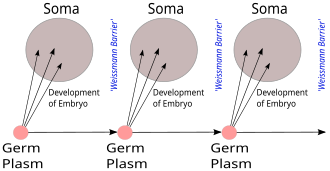
Back البلازما الجرثومية Arabic জার্মপ্লাজম মতবাদ Bengali/Bangla Keimplasmatheorie German Plasma germinal Spanish Plasma xerminal Galician Plasma nutfah ID Plazma zarodkowa Polish Plasma germinativo Portuguese Lý thuyết dòng mầm Vietnamese 种质 Chinese


Germ plasm (German: Keimplasma) is a biological concept developed in the 19th century by the German biologist August Weismann. It states that heritable information is transmitted only by germ cells in the gonads (ovaries and testes), not by somatic cells. The related idea that information cannot pass from somatic cells to the germ line, contrary to Lamarckism, is called the Weismann barrier. To some extent this theory anticipated the development of modern genetics.